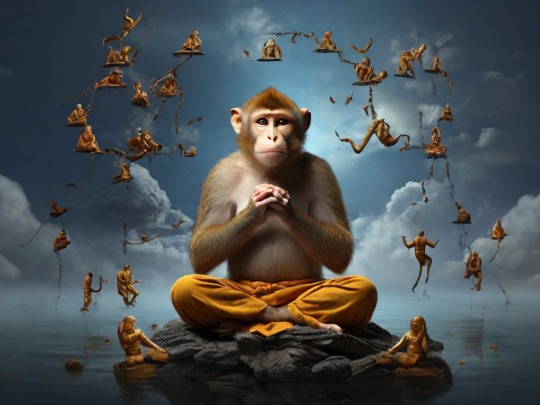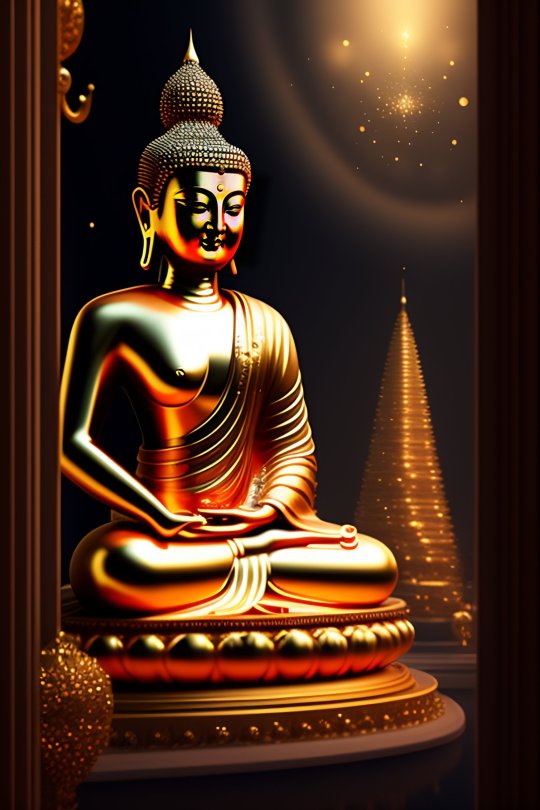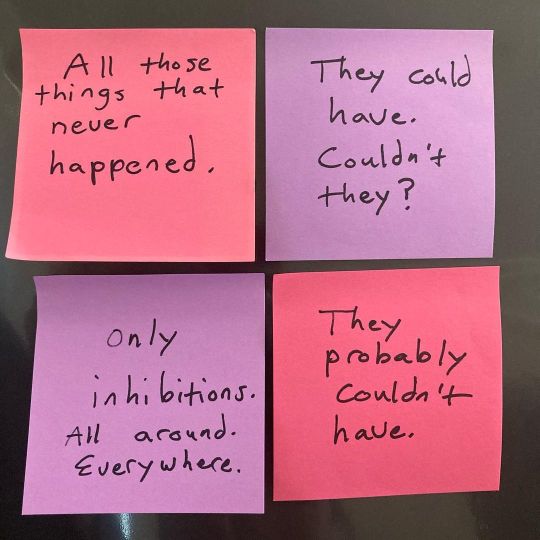#nonattachment
Text
Master Detachment. What stays, stays & what goes, goes..
#letting go#moving on#acceptance#nonattachment#impermanence#mindfulness#zen#taoism#buddhism#stoicism#apathy#indifference#detachment#solitude#independence#self-reliance#freedom
106 notes
·
View notes
Photo

Mujo (moo-jo) Japanese: Impermanence, the concept that everything is in a constant state of change; a reminder to embrace the present moment and let go of attachment to the past or the future.
#Mujo#Japanese#beherenow#everythingchanges#impermanence#letgo#embracethepresent#Nonattachment#joyofexistence#acrylic#painting#artoftheday#artists on tumblr#dailyartwork#artwork#outsiderart#lowbrowart#kunst#flommist#flomm#sadahirecoasters#coasterart#bierdeckel#handpaintedbeercoaster#beercoaster#perspective
3 notes
·
View notes
Text
Taming the Monkey Mind: Buddhist Techniques for Emotional Balance

In the bustling theatre of our minds, emotions often play the leading role, swinging from one thought branch to another like a restless monkey. This constant chatter, known as the "Monkey Mind," can disrupt our emotional equilibrium, leading to stress, anxiety, and discontent. Buddhist teachings offer profound insights and techniques to tame this restless mind, fostering emotional balance and inner tranquility. This article delves into the concept of the Monkey Mind within Buddhist spirituality and provides a practical toolkit to help you cultivate emotional balance in your daily life.
Understanding the Monkey Mind in Buddhist Spirituality
The Monkey Mind, or the restless, unsettled state of mind, is a universal experience characterized by constant mental chatter, distractions, and fluctuations of emotions. In Buddhist spirituality, this phenomenon is closely related to the concept of "Samsara," the cycle of birth, death, and rebirth driven by our attachments, desires, and ignorance.
The Monkey Mind thrives on attachment to outcomes, clinging to past regrets, and fearing future uncertainties. It feeds on judgment, comparison, and the endless pursuit of desires, creating a turbulent inner landscape that clouds our judgment and robs us of peace.
Buddhist Techniques for Taming the Monkey Mind
1. Mindfulness Meditation
What it is: Mindfulness meditation involves cultivating awareness of the present moment, observing thoughts, emotions, and sensations without judgment.
How to practice:
Find a quiet space and sit comfortably.
Close your eyes and focus on your breath.
When your mind wanders, gently bring your attention back to your breath, acknowledging the wandering thought without judgment.
Benefits: Mindfulness meditation enhances self-awareness, reduces stress, and cultivates emotional balance by allowing you to observe the Monkey Mind without getting entangled in its chatter.
2. Practicing Non-attachment
What it is: Non-attachment involves letting go of clinging to desires, outcomes, and expectations, embracing impermanence and accepting the transient nature of life.
How to practice:
Reflect on areas where attachment causes emotional turbulence.
Practice letting go by acknowledging impermanence and focusing on the present moment.
Benefits: Non-attachment fosters emotional resilience, reduces suffering caused by attachment, and promotes a more balanced and equanimous state of mind.
3. Loving-kindness Meditation (Metta)
What it is: Metta meditation focuses on cultivating feelings of love, compassion, and kindness towards oneself and others.
How to practice:
Sit comfortably and close your eyes.
Begin by directing loving-kindness towards yourself, silently repeating phrases like "May I be happy, may I be peaceful."
Extend these feelings towards loved ones, acquaintances, and even those with whom you have conflicts.
Benefits: Metta meditation fosters compassion, reduces negative emotions, and strengthens interpersonal connections, promoting emotional balance and harmony.
4. Mindful Breathing
What it is: Mindful breathing involves focusing on the sensations of breathing, anchoring you in the present moment and calming the Monkey Mind.
How to practice:
Throughout the day, pause and focus on your breath.
Notice the sensations of breathing in and out, allowing it to ground you in the present moment.
Benefits: Mindful breathing promotes relaxation, clarity, and emotional balance, helping you navigate through emotional storms with calmness and poise.
5. Cultivating Gratitude
What it is: Gratitude involves recognizing and appreciating the positive aspects of life, fostering contentment and reducing the Monkey Mind's tendency to focus on negativity.
How to practice:
Keep a gratitude journal and write down three things you are grateful for each day.
Reflect on these moments of gratitude, cultivating a mindset of appreciation and abundance.
Benefits: Cultivating gratitude enhances emotional well-being, shifts focus from lack to abundance, and nurtures a positive outlook, reducing the grip of the Monkey Mind on your emotions.
Food For Thought:
Taming the Monkey Mind is a transformative journey towards emotional balance, inner peace, and spiritual growth. By incorporating mindfulness meditation, non-attachment, loving-kindness meditation, mindful breathing, and cultivating gratitude into your daily routine, you can tame the restless chatter of the Monkey Mind, fostering a more balanced, resilient, and harmonious state of mind.
Embrace these Buddhist techniques with an open heart and a curious mind, and watch as they unravel the knots of emotional turmoil, guiding you towards a life of greater serenity, clarity, and emotional balance.
#MonkeyMind#EmotionalBalance#BuddhistTechniques#MindfulnessMeditation#NonAttachment#LovingKindness#MindfulBreathing#GratitudePractice#InnerHarmony#SpiritualWellness#EmotionalResilience#CalmMind#MindBodySoul#PersonalGrowth#WellnessJourney
1 note
·
View note
Text
Enjoy life without ever seeming terribly…
The phrase "enjoys life without ever seeming terribly attached to it" suggests someone who appreciates and finds pleasure in various aspects of life but maintains a sense of detachment or non-attachment. This could indicate a person who is capable of enjoying experiences and moments without becoming overly emotionally invested or dependent on them.
People who embody this trait often approach life with a certain level of equanimity, not allowing the highs or lows to overly affect their overall well-being. They may have a balanced perspective, valuing experiences for what they are without clinging to them or being excessively attached.
This attitude can be associated with mindfulness and a capacity to saver the present moment without being overly preoccupied with the past or future.
It's important to note that this description can be interpreted in various ways, and individual perspectives on what it means to "enjoy life" and be "attached" can differ. Overall, it suggests a certain level of emotional resilience and a mindful approach to living.
#Mindfulness#Equanimity#Detachment#Enjoyment#BalancedLiving#PresentMoment#EmotionalResilience#SavorLife#PositiveMindset#LifeAppreciation#JoyfulLiving#Happiness#Wellbeing#LiveintheMoment#Nonattachment#Contentment#Lifestyle#MindfulLiving#InnerPeace#Gratitude#deep thinking#deep thoughts
0 notes
Text
Exploring the Depths of Self: A Review of "Who Am I?" by Sri Ramana Maharshi
Sri Ramana Maharshi’s “Who Am I?” is a profound journey into self-exploration and inner peace. In this review, we will delve into the key teachings and takeaways from this silent practice, offering insights into the transformative power of asking the fundamental question, “Who am I?”
The Essence of “Who Am I?” Practice:
At the core of the book is the silent practice itself, urging individuals…

View On WordPress
#ExplorationOfSelf#InnerPeace#LiberationWithin#MaharshiWisdom#NonAttachment#SelfTransformation#SilentPractice#SpiritualJourney#TrueKnowledge#YogiMindset
0 notes
Text
🕊️ Detachment: Finding Freedom in Letting Go 🌿✨
Detachment is the practice of releasing attachment to outcomes, people, or situations, and finding freedom in the act of letting go. It involves relinquishing control and allowing things to unfold naturally. Here are some insights on embracing detachment:
1️⃣ Release Expectations: Let go of rigid expectations and attachments to specific outcomes. Instead, cultivate a mindset of openness and adaptability. Allow life to surprise you and be open to different possibilities that may arise.
2️⃣ Surrender Control: Recognize that there are certain things beyond your control and that trying to force or manipulate outcomes can create unnecessary stress. Surrender control and trust in the process of life. Embrace the flow and accept that things will unfold as they are meant to.
3️⃣ Practice Non-Attachment: Develop a sense of non-attachment to external circumstances. Recognize that your happiness and peace of mind do not depend solely on external factors, but rather on your inner state of being. Detach from the need for validation or approval from others.
4️⃣ Let Go of Past Hurts: Release attachments to past hurts, grievances, and resentments. Holding onto grudges only weighs you down and prevents you from experiencing true freedom. Practice forgiveness and allow yourself to heal and move forward.
5️⃣ Embrace Impermanence: Understand that everything in life is impermanent. People, situations, and circumstances are constantly changing. Embrace the impermanence and flow of life, knowing that everything is transient and subject to change.
6️⃣ Cultivate Mindfulness: Practice mindfulness to bring your awareness to the present moment. By staying grounded in the present, you can let go of worries about the future or regrets about the past. Focus on the here and now and fully engage with what is happening in the present moment.
7️⃣ Nurture Inner Peace: Detachment allows you to cultivate inner peace and tranquility. Focus on nurturing your inner world through self-care practices, meditation, and mindfulness. Create space for stillness and silence within yourself.
8️⃣ Trust the Universe: Develop trust in the universe or a higher power. Believe that there is a greater plan at play, even if you cannot see it at the moment. Trust that everything happens for a reason and that you are always supported.
🕊️✨ Embracing detachment frees you from the chains of attachment and allows you to experience a sense of liberation and inner peace. By releasing expectations, surrendering control, and embracing impermanence, you can cultivate a mindset of detachment and find freedom in letting go. Trust in the process of life and surrender to the flow.
#Detachment#LettingGo#Freedom#Surrender#NonAttachment#EmbraceImpermanence#Mindfulness#InnerPeace#TrustTheUniverse#FlourishWithFreda
1 note
·
View note
Text
Illuminating the Heart's Shadows
Bring all your feelings 😣😖😫 into the light of awareness 🌞🔆, even those you wish you did not have 🙈. Anxiety 😬 and fear 😱 still disturb the depths of your being 🧘♂️. Feelings themselves are not good or bad 😐, but they can lead to unskillful actions 🚫 if not wisely understood 🧠.
Afflictive emotions 😤😡😓 barrage the gates of your heart ❤️ day and night 🌗🌜. Use the shield of mindfulness 🛡️ to recognize them as transient 💨 and not self 🙅♂️. Remember that fear and anxiety are creations of your own mind 🧠. Affirm your trust in the Buddha's teachings 📿, regardless of how turbulent your feelings may be 🌊🌧️. If you persist in practice 🧘♂️, your heart ❤️ will align with the Dharma 📜.
Do not suppress your fears 🚫🙈 or pretend they are not there 👀. Anxiety hidden in the shadowy 🌉 corners of your mind 🧠 gives birth to deeper unease 😣 and aversion 🙅♂️. Bring your troubled thoughts 💭 into the light of compassionate awareness 💡🧘♂️. Examine them with non-judgmental clarity 🌠🔍.
Focus your concentration 🧘♂️ on insight into the empty nature of all phenomena 🕳️. Gradually, afflictive emotions 😡😣😖😫😓 will lose their power over you 💪.
'There is light 💡 in all beings 🙏. May we recognize our shared radiance 😇 of Buddha nature 💎.'There is light 💡 in all beings 🙏. May we recognize our shared radiance 😇 of Buddha nature 💎.

#mindfulness#meditation#buddhism#impermanence#nonattachment#equanimity#compassion#awakening#enlightenment#dhamma#dharma#buddhanature#nonduality#emptiness#middlepath
0 notes
Photo

WILL & FUNCTION are two very different things. What I desire to experience in this life may be different to the function I came here to perform. If we put our will ahead of our function we will continuously experience resistance unless these two dynamics are aligned. If the experiences you desire are in harmony with your function, you will live a very blessed life indeed. We cannot escape our function. And if we manage to align with it, it may become our purpose. But no matter what we choose to do, where, in what capacity and with whom, our function will always work itself through those circumstances, unaffected by our attempts to control ourselves and the circumstances we find ourselves in. This is where choices become very important. We need to lean in to ourselves and love who and how we are. Every character flaw has a flip side. As we work to hone our character in the most harmonious way, our function can perform itself freely and without hindrance. So does what we so desperately want not matter? Are we to be denied our desires? Will it never work out the way we want it to? Function does not alter. Desires do. Desires are uninformed cravings, wishes for hings whose outcomes we are not even abl to imagine or quantify. The less we desire, the greater our function is able to perform itself without hindrance. Our path will flow freely like water. Things will seem easy. But instead we generate new desires at every turn, new things to crave, people too long for and circumstances to aspire to. But desires change and can be changed. They are ephemeral. The nature of our desires issues directly from the state of our character. “It’s just who I am” in reference to desires is an outright decision not to develop our character. Let your goals reflect your function, and you will know satisfaction when you reach them, without the crashing come-down and the need to generate a new desire. Function-led goals arise inspired from the clarity of knowing what you are for, or if you don’t know, trusting that this function will guide you true regardless. This is how to experience the satisfaction we all crave... (continued in comments) #shashaspiritledlife #nonattachment https://www.instagram.com/p/CoFRpZpIQIQ/?igshid=NGJjMDIxMWI=
1 note
·
View note
Photo

NEW BLOG: What A Child’s Shape Sorter Can Teach Us About Non-Attachment Non-attachment defines the absence of attachment to thoughts, feelings, and the subsequent need to control them, so let me ask you, is it time for you to let go of what is no longer serving you well? If so, please read how practicing non-attachment can help you, link in bio #newblog #lifecoachingblog #personaldevelopmentblog #blogger #blogarticle #newblogrelease #lifecoaching #lifecoachingtips #persoanldevelopmentcoach #karanscott #karanscottnlpperformancecoach #karanscottcognitivebehaviouraltherapist #cbtcoaching #nlpcoaching #lifecoachwriter #lifecoachauthor #nonattachment #changeyourthoughts #neutraliseego https://www.instagram.com/p/CjND1EODwt-/?igshid=NGJjMDIxMWI=
#newblog#lifecoachingblog#personaldevelopmentblog#blogger#blogarticle#newblogrelease#lifecoaching#lifecoachingtips#persoanldevelopmentcoach#karanscott#karanscottnlpperformancecoach#karanscottcognitivebehaviouraltherapist#cbtcoaching#nlpcoaching#lifecoachwriter#lifecoachauthor#nonattachment#changeyourthoughts#neutraliseego
0 notes
Photo

#practice #postits #nonattachment https://www.instagram.com/p/Chix4K_FTL4/?igshid=NGJjMDIxMWI=
0 notes
Link
1 note
·
View note
Photo

🐍 Serpent (1st Chakra): Mother of the Waters. Archetypical Healer in many cultures, Similar to the Spider in Native American cultures. She teaches us to "Shed Our Past", freeing ourselves to walk with forgotten innocence & Splendor Upon this Earth. 🐍🕷 ■ South Insights or Practices ■ ▪︎The Practice of NonJudgment ▪︎The Practice of Non-Suffering ▪︎The Practice of Nonattachment ▪︎The Practuce of Beauty 🐍Each Animal Helps Us in Our Journey🐍 🕷 🐍 🕷 🐍 🕷 🐍 🕷 🐍 🕷 🐍 #SpreadYourMusictotheWorld #Shamanism #ReikiMaster #releaseoldpatterns #reptilianshapeshifters #nonattachment #spirituality #healyourself #healtrauma #AlienFromSpace #nonjudgement #albertovilloldo #thefourinsights #nonsuffering #changeyourmindset #changeyourlife #soulwork #southdirection #sachamama #luminousenergyfield #multidimensional #doslopez #Practices #shedyourskin #motherofthewaters #greatserpent #beauty #nativeamerican #southamerica #Mexico https://www.instagram.com/p/CdOSxH2rQcN/?igshid=NGJjMDIxMWI=
#spreadyourmusictotheworld#shamanism#reikimaster#releaseoldpatterns#reptilianshapeshifters#nonattachment#spirituality#healyourself#healtrauma#alienfromspace#nonjudgement#albertovilloldo#thefourinsights#nonsuffering#changeyourmindset#changeyourlife#soulwork#southdirection#sachamama#luminousenergyfield#multidimensional#doslopez#practices#shedyourskin#motherofthewaters#greatserpent#beauty#nativeamerican#southamerica#mexico
0 notes
Text
Despite the fanon(/fandom) jokes about Plo Koon and attachment, he actually does a very good job of letting go of Ahsoka. The advice he gives Anakin in the Trandosha arc -- that he has prepared Ahsoka all he can for this situation, and there is nothing more he can do now, and that doesn’t mean he’s letting her down -- is from his own experience.
He wanted her to be his Padawan. He expected her to be his Padawan.
He has a nickname for her (much like Anakin has ‘Snips’), and they share a greeting ritual from his homeworld. He judges Anakin’s teaching to Ahsoka, indicating in no uncertain terms he thinks the way he wants to teach her is better; “You have inherited many of your Master’s ways, including a... lack of subtlety.”
Even in the Trandosha arc itself -- what Anakin describes as Ahsoka’s strength, Plo says can also be a weakness. Plo asks rhetorically if she’s a worthy apprentice, and Anakin says nobody has her kind of determination (which isn’t exactly a ‘yes’), and Plo says “Except you”. (“You have inherited many of your Master’s ways, including a... lack of subtlety.”)
Yet, when Ahsoka goes to him for help defying Anakin, he backs up Anakin’s decision, and he says “He is your Master.” He might not like that, but he respects it, and he expects Ahsoka to respect it as well.
Back to the room in the Temple when Ahsoka has been captured by the Trandoshan hunters. He says “If you have trained her well, she shall take care of herself”. If. It’s pretty clear he isn’t sure that Anakin has trained her well. You know the moment when Anakin demands to know why Obi-wan isn’t on edge, and Obi-wan responds that he’s better at hiding it? I’m pretty sure that’s what’s going on with Plo, in that moment.
#look i just love how judgy plo is of anakin's teaching out of what's quite obviously jealousy#but still managing to toe the line of practising and preaching nonattachment towards her to anakin#...it's hard to be worse at nonattachment than anakin#but plo is still mature and respectful about it when it comes down to it.. except for a little bit slipping out when anakin's talking about#being a bad master#can't quite hold back all of his automatic response of yes. yes you are. glad you noticed#star wars#tcw#plo koon#ahsoka tano#anakin skywalker#master plo and little soka#meta#my meta#*
310 notes
·
View notes
Text
so in the disneyverse grogu-din's bond is gonna be the one of the big Reasons luke goes full steam ahead on the "attachments are ok" front to his currently developing teaching method, right?
#i mean i think ppl misinterpret his scene with grogu and the beskar shirt and lightsaber#i dont think he was promoting nonattachment#which is his biggest and best deviation from the Old Order (and why it failed)#i think he was just giving grogu an out essentially snd presenting him w a choice so he could choose what his heart wanted (his dad)#for himself#but also i do think witnessing din/grogus bond is going to be a big Moment for luke in this verse and ultimately convince him his desire to#found a school with jedi of all ages and familial situations is the Way to go#which is baller#luke skywalker#din djarin#din grogu#dinluke#or it would be if they ever showed us things we wanted to see and can extrapolate from the released media lmao#the mandalorian
56 notes
·
View notes
Text
Just watched a relative try to skip the work of shredding cheese for baked mac and cheese by cutting it into little cubes and stirring them into the mac and cheese sauce. It’s in the baking dish now and there are still big orange cubes all through it. Life is so hard when the options are either know-it-all micromanaging or having to eat a dish somewhere in the subpar to abysmal range…
#and do not get me started on this crisco pie crust. my god#i am however finally reaching a completely serene and nonattached approach. the dishes I cooked are done well and that’s all I can do#anything goes at this point I’m drinking bourbon creams with nutmeg. I’m lying down in a closet in the attic with the noise cancelings
7 notes
·
View notes
Text
im very glad that ive freed myself of keeping mutuals and worrying if i move or w/e if they’ll follow. i drop my link and my mssg and i dip til the next time i leave a reminder. at this point sis if i see u, i see u. im going to the gas station for passionfruit juice and beef snacks u can come along or dont. stay in the car. idc
#🌙 OOC! THE DARKENED EYES OF MARS.#/ im a very nonattached person......#/ but i think that benefits me on the internet.#/ and irl. even tho people call me frigid and almost a complete patrick bateman because of it.
7 notes
·
View notes